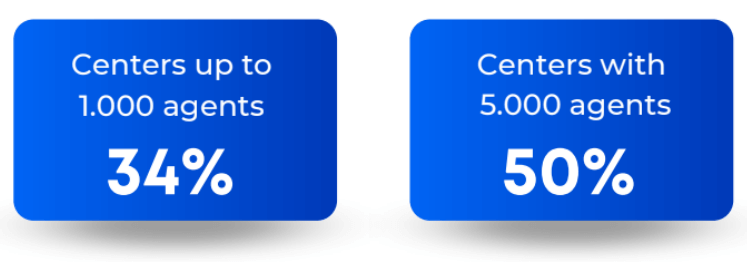The CX Butterfly Effect
The CX butterfly effect illustrates how even minor adjustments in customer experience strategies can lead to significant and far-reaching impacts on overall business outcomes. The butterfly effect is a concept from chaos theory that suggests small changes in the initial conditions of a dynamic system can have large and unpredictable effects on the outcome of the system over time.
It is often metaphorically represented by the idea that the flapping of a butterfly’s wings in one part of the world might ultimately contribute to causing a tornado in another part of the world.
Applying this principle to customer experience (CX) reveals that even seemingly minor issues, such as a long queue, can set off a chain reaction that ripples through an entire organization.
Let’s dive into how the CX Butterfly Effect happens and why it really matters.

The Spark – Customer Frustration
First off, nobody likes to wait. And in customer service, where the average person will spend 43 days on hold over the course of their life, long queues often mark the first point of frustration—a classic example of the CX butterfly effect. Imagine one calls about a quick question on their bill and ends up stuck on hold for 20 minutes.
Studies show that the longer customers wait, the less likely they are to have a positive view of the company. When customers start off frustrated, the situation can quickly deteriorate.
Navigating through a long and complicated menu can add to this frustration. It’s akin to being lost in a maze, trying to find the right option that hopefully leads to a human voice. To make matters worse, sometimes when one thinks they’re about to get help, they are instead met with an unhelpful automated bot.
And when they finally connect with a human, they often find themselves having to repeat all the information they’ve already provided as if none of it was recorded. This kind of redundancy only compounds the irritation and can sour the overall customer experience, further demonstrating the CX butterfly effect—where small inefficiencies can escalate into major dissatisfaction.
The Ripple – Impact on Agents
This frustration doesn’t stop with the customer. It spills over to the agents too, illustrating the CX butterfly effect in action. Picture this: you’re a customer service agent, and almost every caller is already irritated by the time you greet them.
This constant barrage of negativity can really wear agents down, making their shifts feel longer and a lot more stressful. When every day is a bad day, it’s not surprising that many decide to throw in the towel.
Moreover, when agents aren’t adequately trained to handle diverse inquiries, their confidence and effectiveness diminish. They’re left feeling underprepared and overwhelmed, which can further impact their morale and performance. This is another example of the CX butterfly effect, where small gaps in training can lead to larger issues in both employee satisfaction and customer outcomes.
Additionally, the need to juggle multiple software applications to manage customer interactions adds another layer of complexity and frustration. This disjointed tool landscape not only slows down the process but also increases the likelihood of errors, adding stress to an already tense environment.
The situation is made even worse during peak hours when there are not enough hands on deck due to inaccurate workforce forecasting. This lack of staffing leads to longer wait times, more frustrated customers, and even more pressure on the agents who are available, creating a vicious cycle of dissatisfaction and burnout.
Compounding these challenges is the relentless cycle of turnover. Experienced agents, worn out by the demands of the job, often leave, creating a gap that is filled by new, less experienced agents. These newcomers, still in training, are not fully equipped to handle complex customer issues effectively. This places an even greater burden on the remaining experienced agents, who must pick up the slack, often at the cost of their own well-being.

The Surge – Organizational Consequences
Workforce Management (WFM) helps reduce the expenses that come with agent churn. High turnover leads to added costs, from hiring and training to other less obvious impacts.
For example, when agents begin to leave, the responsibility falls heavily on the HR team. They find themselves back at the starting point, trying to fill positions that are notoriously difficult to keep filled. This scenario highlights the CX butterfly effect, where initial challenges in agent retention can create a ripple effect, leading to ongoing staffing issues and operational disruptions.
The cycle of continuously hiring and training new staff is not only exhausting but also financially burdensome. Significant resources are invested in recruitment and training, only to have to repeat this process over again soon after.
This cycle of departing experienced staff and incoming inexperienced ones perpetuates inefficiencies and dissatisfaction across the board, straining the entire customer service ecosystem. This ongoing turnover is a clear manifestation of the CX butterfly effect, where small disruptions in staffing can escalate into widespread challenges for both employees and customers.

The Tsunami – Executive Headaches
Challenges such as high turnover, customer dissatisfaction, and escalating costs create significant operational and financial burdens. These pressures compel executives to address these problems swiftly to prevent broader organizational repercussions, including impacts on the company’s financial health.
The financial implications of these customer service challenges are substantial. Research from the Center for American Development (CAD) highlights the high costs of employee turnover, noting that replacing an agent typically costs about 16% of their annual salary for those earning under $30,000 a year. This figure increases to 20% for managerial positions with salaries between $30,000 and $50,000.
Furthermore, the consequences of customer dissatisfaction are extensive, affecting the bottom line significantly. Unhappy customers not only reduce direct revenue through churn but also deter potential future sales and referrals. The negative impact on a brand’s reputation from poor customer experiences can severely hamper efforts to attract new customers, particularly in an era dominated by online reviews and social media influence. This exemplifies the CX butterfly effect, where a single negative interaction can trigger a chain reaction of adverse business outcomes.
Companies can experience more than 80% churn due to poor CX, illustrating the critical need for robust customer service management and comprehensive agent training programs.
Conclusion
If you are seeking another compelling reason to focus on customer retention, consider the substantial financial impact: a modest increase of just 5% in customer retention can boost company revenues by 25% to 95%.
The significance of customer service cannot be overstated in shaping the success and reputation of a business. This is where the CX butterfly effect comes into play, as even small changes or lapses in customer service can lead to far-reaching consequences for both customer satisfaction and overall business performance..
It’s often the case that many organizations are not fully aware of the inefficiencies within their contact centers, though they recognize that something isn’t functioning optimally.
FrontLogix offers specialized Tiger Team services designed to refine and empower your support team . Through a comprehensive approach that includes a Deep Dive Assessment, Tailored Strategies, and Knowledge Transfer, FrontLogix integrates with your existing framework to pinpoint challenges and implement effective solutions.

STRATEGY GUIDE
6 Simple Strategies To Improve Customer Retention
Actionable insights and proven techniques to keep your customers coming back.


Found this useful?
Subscribe to our newsletter and get CX and WFM news delivered to your inbox.
Don’t worry, we won’t flood your inbox – just one insightful email a month!



















